The AMD Radeon R9 290 Review
by Ryan Smith on November 5, 2013 12:01 AM EST- Posted in
- GPUs
- AMD
- Radeon
- Hawaii
- Radeon 200
Overclocking
Finally, let’s spend a bit of time looking at the overclocking prospects for the 290. Without any voltage adjustment capabilities and with AMD binning chips for clockspeeds and power consumption we’re not necessarily expecting a lot of headroom here, but none the less it’s worth checking out to see how much more we can squeeze out of the card.
Even though we’re officially limited to AMD’s Overdrive utility for the moment for overclocking, Overdrive offers a wide enough range of values that we shouldn’t have any problem maxing out the card. In fact we’ll be limited by the card first.
| Radeon R9 290 Overclocking | |||
| Reference Radeon R9 290 | |||
| Shipping Core Clock | 662MHz | ||
| Shipping Boost Clock | 947MHz | ||
| Shipping Memory Clock | 5GHz | ||
| Shipping Boost Voltage | ~1.18v | ||
| Overclock Core Clock | 790MHz | ||
| Overclock Boost Clock | 1075MHz | ||
| Overclock Memory Clock | 5.6GHz | ||
| Overclock Max Boost Voltage | ~1.18v | ||
Despite the lack of voltage control, when it comes to overclocking the 290 we were able to achieve solid overclocks on both the GPU and the memory. On a boost clock basis we were able to push the 290 from 947MHz to 1075MHz, an increase of 128MHz (14%). Meanwhile we were able to push the memory from 5GHz to 5.6GHz before artifacting set in, representing a 600MHz (12%) memory overclock. Being able to increase both clockspeeds to such a similar degree means that no matter what the video bottleneck is – be it GPU or memory – we should see some kind of performance increase out of overclocking.
On a side note, for overclocking the 290 we stuck with moderate increases to both the maximum fan speed and the PowerTune limit. In the case of the former we used a 65% maximum fan speed (which actually proved to be more than what’s necessary), while for the latter we went with a 20% increase in the PowerTune limit, as at this point in time we don’t have a good idea for what the safe power limits are for the reference 290/290X board. Though in either case only FurMark could push the overclocked card to its power limit, and nothing could push the card to its fan speed limit. Similarly we didn’t encounter any throttling issues with our overclocked settings, with every game (including CoH2) running at 1075MHz sustained.
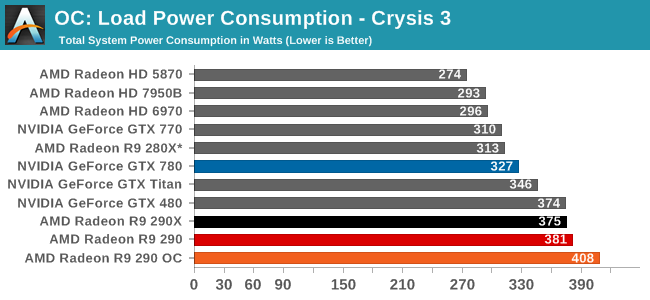

Taking a brief look at power, temp, and noise before jumping into our gaming performance results, we can see that overclocking the card has a measurable impact on power consumption under both Crysis 3 and FurMark. With Crysis 3 we’re clockspeed limited before we’re power limited, leading to an increase in power consumption of 27W, while under FurMark where we were power limited it’s a much more academic increase of 87W.
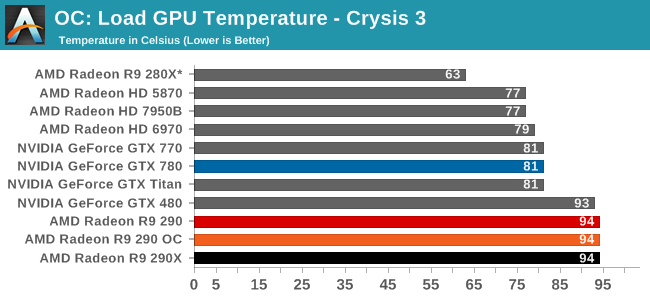
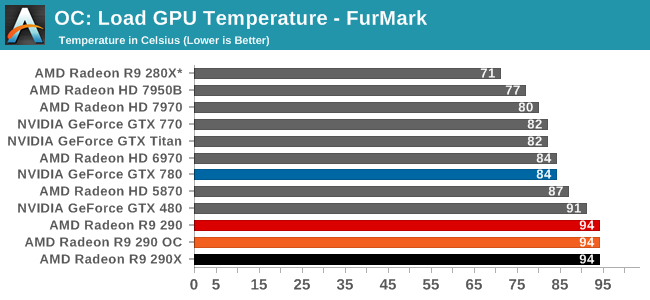
Since the 290 already ships at the highest temperate limit it allows – 95C – our sustained temperatures are unchanged even after overclocking.
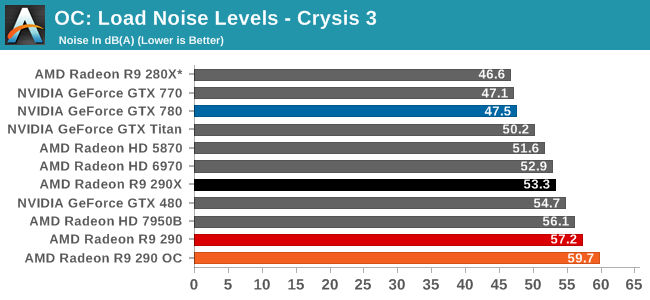
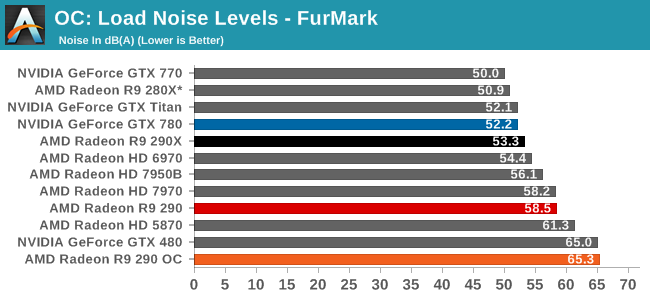
The 290 is already an unreasonably loud card at stock, and unfortunately the fan speed increases needed to handle the greater heat load from overclocking only make this worse. Under Crysis 3 we peaked at 59.7dB, or 49% fan speed. While under FurMark we peaked at 65.3dB, or 59% fan speed. For these noise levels to be bearable the 290 really needs to be fully isolated (e.g. in another room) or put under water, as otherwise 59.7dB sustained is immensely loud for a video card.
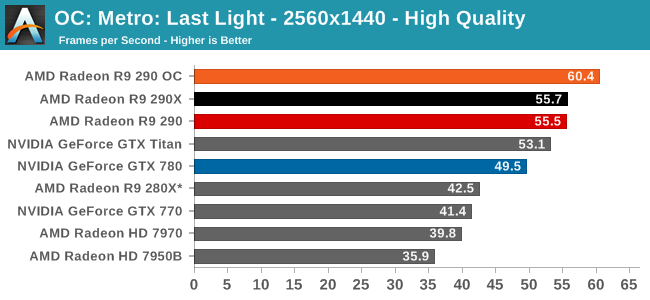

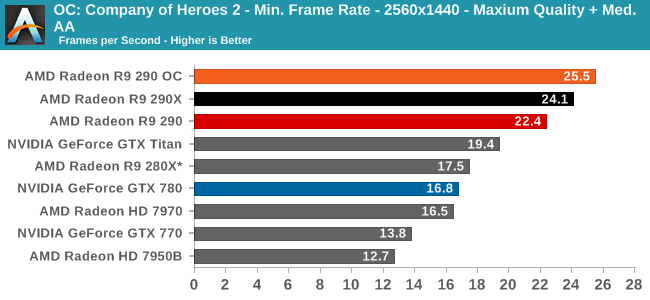
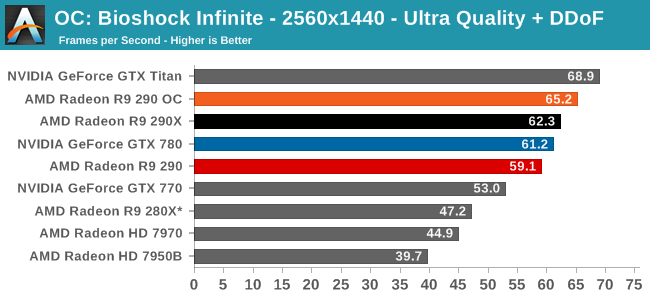
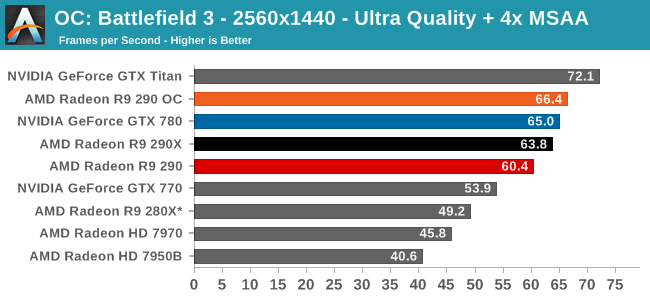
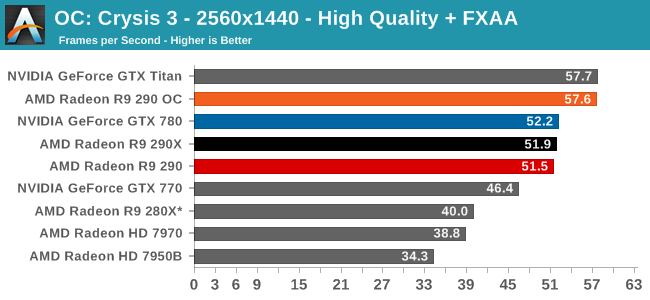
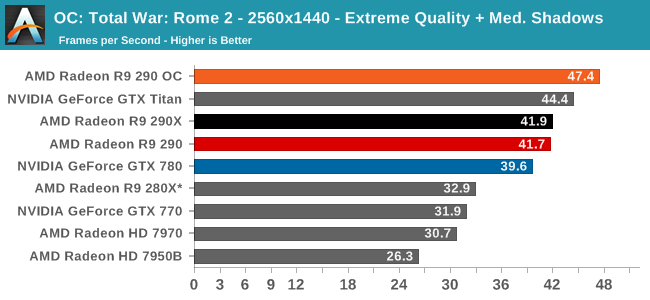
Finally getting to the matter of game performance, we’re seeing consistently strong scaling across every game in our collection. The specific performance increase depends on the game as always, but a 14% core overclock and 12% memory overclock has netted us anywhere between 9% in Metro up to the full 14% in Total War: Rome II. At this performance level the 290 OC exceeds the performance of any other single-GPU card at stock, and comes very close to delivering 60fps in every action game in our benchmark suite.










295 Comments
View All Comments
Pierreso - Tuesday, November 5, 2013 - link
Amazing indeed! $400 for a card up there with Titan often and leaving behind the 780. This is really great!Jimminycricket - Tuesday, November 5, 2013 - link
Was waiting patiently for 290 reviews all night and read several. What a read this is.This here is THE card to get. The value and performance is off the charts. AMD 290 performs better than nvidia Gtx780 in almost every case and you can overclock it for even more coming up towards 290X numbers. The new review AMD drivers made performance through the roof. AMD 290 also is right there with $1000 wallet-buster Titan.
And $400! Finally we get amazing value and beastly performance at a good pricepoint.I was considering the Gtx780 but with this beast from AMD nvidia needs another $150 pricecut on GTX780 down to $350 otherwise it is $400 AMD 290 in my rig allday. $400 Beast!
jerkchickens - Tuesday, November 5, 2013 - link
no doubt, nvidia, time for another price cut GTX780=$350 value now. R9 290 $400 and kicks its buttSamus - Tuesday, November 5, 2013 - link
I'm surprised AMD isn't selling a first-party solution for this if the cooling benefit is so substantial with GCN 1.1Water cooling kit = volume solved.
holdingitdown - Tuesday, November 5, 2013 - link
Custom cards will be here in no time. Per reviewers comments elsewhere AMD is waiting for 780ti to release then they drop the custom 290x and 290 cards and crush that card too.So much for nvidia trying to charge $699 fir 780ti. Propaply that card will be $599 oi instead.
crispyitchy - Tuesday, November 5, 2013 - link
290 is the best card to release on 28nm.Wicked fast and priced right $400.
With these new AMD cards and their aggressive pricing and top tier performance, nvidia's entire lineup is irrelevant until they do some serious price drops.
290 is indeed a beast!
crispyitchy - Tuesday, November 5, 2013 - link
Take a look at this reviewIt really paints how amazing the card is.
http://www.hardocp.com/article/2013/11/04/amd_rade...
Notmyusualid - Tuesday, November 5, 2013 - link
440W.designerfx - Tuesday, November 5, 2013 - link
It's definitely refreshing to know AMD is definitely going for direct competition with Nvidia with the 290.Sabresiberian - Friday, November 8, 2013 - link
And, water cooling bumps the price up at least $75 for the block, assuming you have an existing pump and radiator that will take the added load.It is the only card to get IF you don't care about noise or are willing to spend a significant amount of money to get rid of the noise, don't care about G-sync, don't care about PhysX, and don't care about Shield compatibility. Me, I'd rather spend $500 on a card that doesn't give up those things and doesn't force me to change the cooling solution.